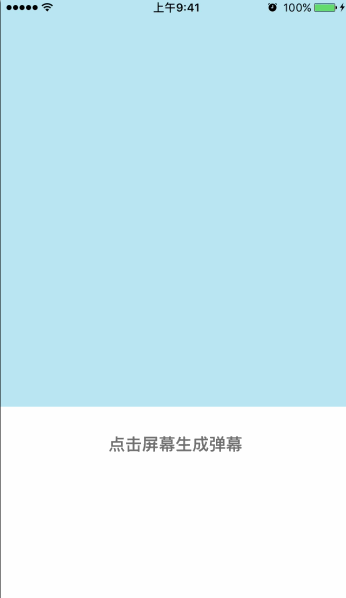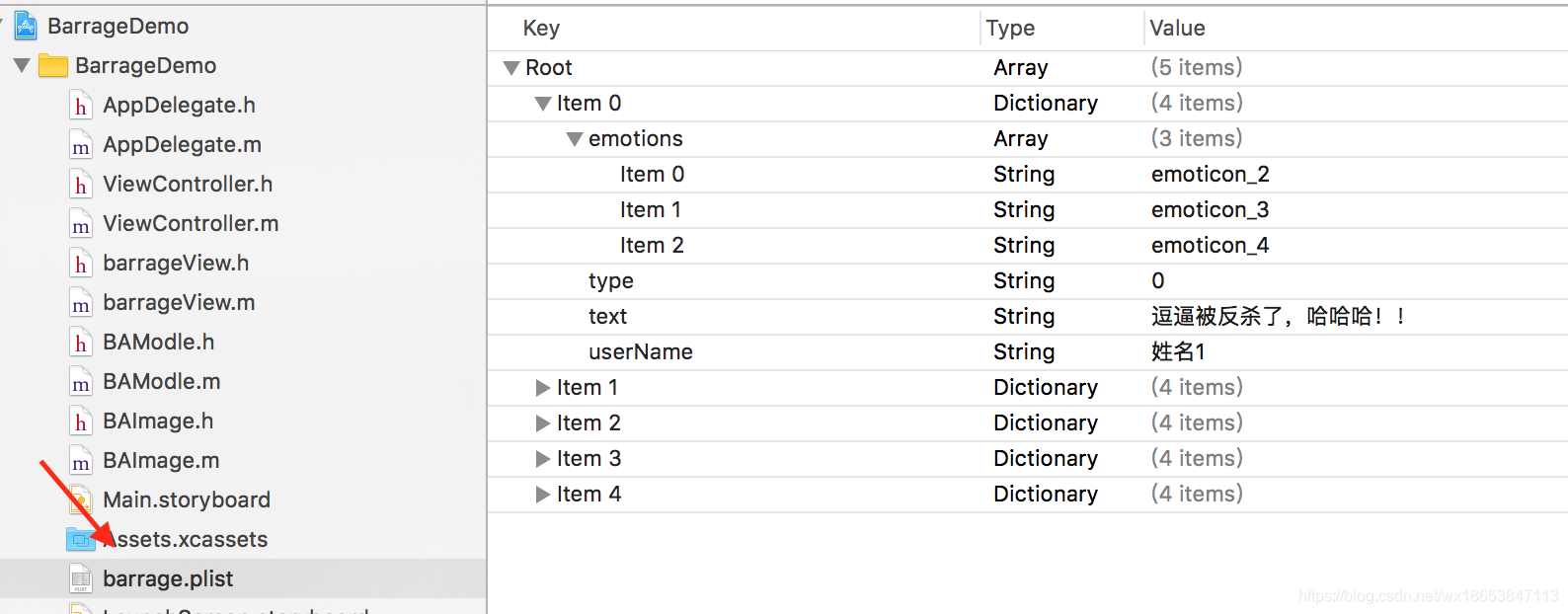看直播的童鞋们应该会经常看到满屏幕的滚动弹幕,看到密密麻麻的弹幕第一印象就是怎么样高效加载来避免卡顿,弹幕组成部分包含用户头像、用户昵称、弹幕的内容、表情等,本文介绍的实现原理就是把这几部分绘制成一张图片,然后通过定时器移动弹幕图片,当图片不在屏幕范围内即销毁。
先看下效果


下面我会详细介绍下实现原理
1 .获取弹幕数据来源,因为我是模拟生成弹幕,弹幕的数据存放在工程里的plist文件中

barrage.plist
emotions存放这条弹幕的表情,type表示是否是自己发的,text表示弹幕内容,userName表示用户昵称。取出plist文件的数据并转换成model。
#pragma mark - 获取数据源
- (void)loadData{
// 获取plist全路径
NSString *filePath = [[NSBundle mainBundle] pathForResource:@"barrage.plist" ofType:nil];
// 从指定的路径中加载数据
NSArray *array = [NSArray arrayWithContentsOfFile:filePath];
// 遍历数组
for (NSDictionary *dict in array) {
// 字典转模型
BAModle *barrageM = [BAModle barrageWithDict:dict];
[self.danMus addObject:barrageM];
}
}
2 .根据模型生成弹幕图片,通过点击屏幕生成模型,根据模型绘制图片。
#pragma mark - 触摸屏幕响应事件
- (void)touchesBegan:(NSSet<UITouch *> *)touches withEvent:(UIEvent *)event{
// 获得一个随机整数
NSInteger index = arc4random_uniform((u_int32_t)self.danMus.count);
// 获得一个随机模型
BAModle *danMu = self.danMus[index];
// 根据模型生成图片
BAImage *image = [self.danMuview imageWithBarrage:danMu];
// 调整弹幕加载区域
image.x = self.view.bounds.size.width;
image.y = arc4random_uniform(self.danMuview.bounds.size.height - image.size.height);
// 把图片加到弹幕view上
[self.danMuview addImage:image];
}
下面是具体绘制弹幕图片过程,我先简单介绍下,首先在绘图之前要确定上下文的尺寸,相当于画板的大小,画板的长 = 头像的长 + 昵称的长 + 内容的长 + 表情的长 * 表情个数 + 间距。然后就是分别绘制背景图片,用户昵称,内容和表情,最后返回一张图片。
此处有两点需要注意:
1.由于头像是矩形,想显示成圆形,要先画一个圆,并设置超出圆形的部分要裁剪,再绘制头像。
2.由于上面设置超出圆形的部分要裁剪,那即将要绘制背景岂不是要被裁剪,所以在绘制圆形区域上一句执行了CGContextSaveGState(ctx)表示复制了一份画板(上下文)存到栈里,在绘制背景图片之前执行CGContextRestoreGState(ctx),表示用之前保存的画板替换当前的,因为之前保存的画板没有设置超出圆形区域要裁剪的需求,当然替换当前的画板,会把当前画板上的绘图也copy过去。
#pragma mark - 绘制弹幕图片
- (BAImage *)imageWithBarrage:(BAModle *)danMu{
// 开启绘图上下文
//
UIFont *font = [UIFont systemFontOfSize:13];
// 头像
CGFloat iconH = 30;
CGFloat iconW = iconH;
// 间距
CGFloat marginX = 5;
// 表情的尺寸
CGFloat emotionW = 25;
CGFloat emotionH = emotionW;
// 计算用户名占据的区域
CGSize nameSize = [danMu.userName boundingRectWithSize:CGSizeMake(MAXFLOAT, MAXFLOAT) options:NSStringDrawingUsesLineFragmentOrigin attributes:@{NSFontAttributeName:font} context:nil].size;
// 计算内容占据的区域
CGSize textSize = [danMu.text boundingRectWithSize:CGSizeMake(MAXFLOAT, MAXFLOAT) options:NSStringDrawingUsesLineFragmentOrigin attributes:@{NSFontAttributeName:font} context:nil].size;
// 位图上下文的尺寸
CGFloat contentH = iconH;
CGFloat contentW = iconW + 4 * marginX + nameSize.width + textSize.width + danMu.emotions.count * emotionH;
CGSize contextSize = CGSizeMake(contentW, contentH);
UIGraphicsBeginImageContextWithOptions(contextSize, NO, 0.0);
// 获得位图上下文
CGContextRef ctx = UIGraphicsGetCurrentContext();
// 将上下文保存到栈中
CGContextSaveGState(ctx);
// 1.绘制圆形区域
CGRect iconFrame = CGRectMake(0, 0, iconW, iconH);
// 绘制头像圆形
CGContextAddEllipseInRect(ctx, iconFrame);
// 超出圆形的要裁剪
CGContextClip(ctx);
// 2.绘制头像
UIImage *icon = danMu.type ? [UIImage imageNamed:@"headImage_1"]:[UIImage imageNamed:@"headImage_2"];
[icon drawInRect:iconFrame];
// 将上下文出栈替换当前上下文
CGContextRestoreGState(ctx);
// 3.绘制背景图片
CGFloat bgX = iconW + marginX;
CGFloat bgY = 0;
CGFloat bgW = contentW - bgX;
CGFloat bgH = contentH;
danMu.type ? [[UIColor orangeColor] set]:[[UIColor whiteColor] set];
[[UIBezierPath bezierPathWithRoundedRect:CGRectMake(bgX, bgY, bgW, bgH) cornerRadius:20.0] fill];
// 4.绘制用户名
CGFloat nameX = bgX + marginX;
CGFloat nameY = (contentH - nameSize.height) * 0.5;
[danMu.userName drawAtPoint:CGPointMake(nameX, nameY) withAttributes:@{NSAttachmentAttributeName:font,NSForegroundColorAttributeName:danMu.type == NO ? [UIColor orangeColor]:[UIColor blackColor]}];
// 5.绘制内容
CGFloat textX = nameX + nameSize.width + marginX;
CGFloat textY = nameY;
[danMu.text drawAtPoint:CGPointMake(textX, textY) withAttributes:@{NSAttachmentAttributeName:font,NSForegroundColorAttributeName:danMu.type == NO ? [UIColor blackColor]:[UIColor whiteColor]}];
// 6.绘制表情
__block CGFloat emotionX = textX + textSize.width;
CGFloat emotionY = (contentH - emotionH) * 0.5;
[danMu.emotions enumerateObjectsUsingBlock:^(NSString *emotionName, NSUInteger idx, BOOL * _Nonnull stop) {
// 加载表情图片
UIImage *emotion = [UIImage imageNamed:emotionName];
[emotion drawInRect:CGRectMake(emotionX, emotionY, emotionW, emotionH)];
// 修改emotionX
emotionX += emotionW;
}];
// 从位图上下文中获得绘制好的图片
UIImage *image = UIGraphicsGetImageFromCurrentImageContext();
return [[BAImage alloc] initWithCGImage:image.CGImage scale:[UIScreen mainScreen].scale orientation:UIImageOrientationUp];
}
3 .开启绘图定时器,回调方法是setNeedsDisplay,这样就会执行- (void)drawRect:(CGRect)rect每次修改image.x(由于UIImage没有x、y属性,所以写了个类拓展BAImage),滚动不在屏幕范围内的会销毁
#pragma mark - 添加定时器
- (void)addTimer{
if (self.link) {
return;
}
// 每秒执行60次回调
CADisplayLink *link = [CADisplayLink displayLinkWithTarget:self selector:@selector(setNeedsDisplay)];
// 将定时器添加到runLoop
[link addToRunLoop:[NSRunLoop currentRunLoop] forMode:NSRunLoopCommonModes];
self.link = link;
}
#pragma mark - 绘制移动
- (void)drawRect:(CGRect)rect{
for (BAImage *image in self.imageArray) {
image.x -= 3;
// 绘制图片
[image drawAtPoint:CGPointMake(image.x, image.y)];
// 判断图片是否超出屏幕
if (image.x + image.size.width < 0) {
[self.deleteImageArray addObject:image];
}
}
// 移除超过屏幕的弹幕
for (BAImage *image in self.deleteImageArray) {
[self.imageArray removeObject:image];
}
[self.deleteImageArray removeAllObjects];
}